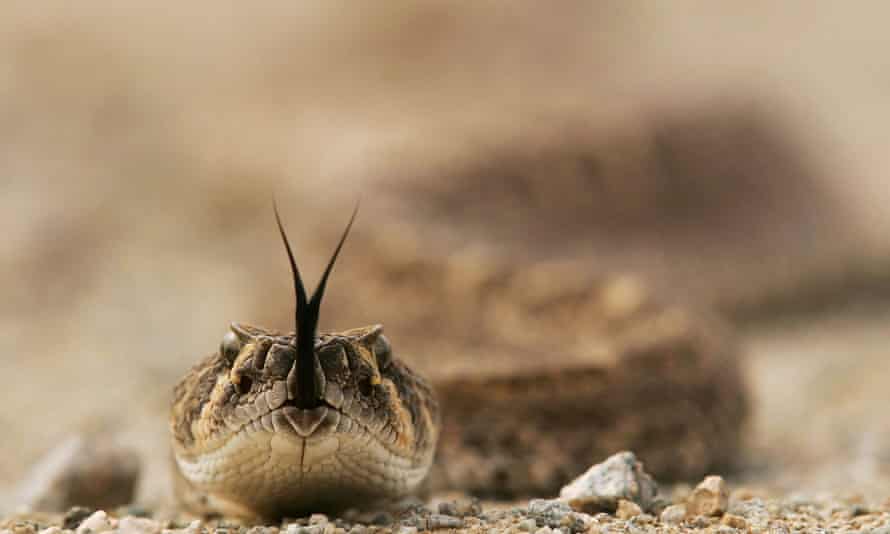Len Ramirez stalked through the dried landscape, scanning the ground ahead searching for movement. Called out to an estate in Napa Valley, the owner of Ramirez Rattlesnake Removal company was finishing up his last job of another busy day wrangling, removing and relocating snakes from homes across northern California. He’d found three in just this yard, including one nestled roughly 1,000 yards from the pool.
Rattlesnakes are everywhere these days, he says – on front porches, in potted plants, and under children’s play equipment. “I am busier than I have ever been. Complaints are coming in from all over the state.”
Ramirez believes the drought may be partly to blame. He opened his business in 1985, and has seen spikes before. And while he doesn’t think the rattlesnake population is necessarily growing, snakes are increasingly finding their way into urban environments in search of refuge from the rising temperatures and relief from the drying landscape.
And it’s not just snakes.
California and other states across the south-west are in the grips of a historic drought. The conditions have produced consequences that extend beyond the risks of a decreased water supply and worsening wildfires. And as urban development creeps further into once-wild areas, the drought has also increased negative interactions between people, animals and pests – who are all trying to adapt.
“Rattlesnakes are becoming more common in the places where we live, work and play,” Ramirez says. After opening his business in 1985, he’s become a go-to source for removal and public education about the snakes, speaking to the media and producing safety videos for California’s office of emergency services. He clears snakes from properties and public areas and relocates them to uninhabited areas.

Ramirez worked through California’s last drought – which stretched from the end of 2011 to 2019 – and saw similar patterns. But now it’s gotten worse, mostly because he says, “there is so much development taking place, and that’s going to displace wildlife, including rattlesnakes”.
Ramirez says he’s had jobs when he has had to remove more than 60 snakes at a time. “I always remind parents to be a good scout before your kids go out to play,” he says.
As essential water sources start to run dry, other wild animals have also been spotted searching the suburbs for water, sustenance and reprieve from the intensifying conditions. Wildlife veterinarians have reported the numbers of abandoned babies or injured animals brought into their centers and animal sightings – especially of bears who are venturing deeper into urban areas – are surging.
“The bear population is expanding its range, so bears are showing up in areas where they’ve never seen before,” Rebecca Barboza, a wildlife biologist who studies the trend for the California department of fish and wildlife, told ABC News this month.
Smaller animals and insects are also coming closer in search of water – and some have the ability to cause a lot more damage. Song birds carrying the West Nile virus, which can cause a deadly and debilitating neurological disease, are increasingly showing up in back yards.
“Because there’s limited water in the environment and everything is dry, the birds go looking for water and refuge,” says Cameron Webb, a medical entomologist and senior investigator with the Centre for Infectious Diseases and Microbiology – Public Health who studies the mosquitoes that transmit the disease. “You get this combination of factors that means not only are conditions suitable for mosquitoes, but also the birds that carry the virus are more likely to be in higher concentration closer to where people live.”
Surprisingly, disease-carrying mosquitoes, which most people associate with wet times rather than dry, thrive in cities during times of drought when waters recede and grow still. Webb explains that human-made structures like pipes, pits and ponds are prime spots for stagnant water to become a breeding ground for the insects. “Fish and other animals that live in these systems die and the mosquitoes have free rein”.
In California, public health officials have already warned residents of an increase in virus activity and scientists believe the threat of transmissions of West Nile will increase with climate change, especially in coastal areas of California.
Less perilous pests may also pose more problems during drought conditions. Ants, cockroaches and rodents and other visitors also need water to survive and human homes are typically where they go to find it when it’s absent in outdoor environments.
“Drought conditions not only mean that a pest’s water supply dries up, but natural food sources can also be harder to find as well,” Mike Bentley, an entomologist for the National Pest Management Association, says. “Drought often drives pests into homes or other structures in search of these resources to survive”.
Not only does the drought mean an increase in unwanted houseguests, but it’s changing the behavior of critters themselves. They are “incredible at adapting to change”, he says. “This can mean rodents nesting in wall voids versus underground burrows and feeding from garbage bags rather than fallen fruits and seeds. Or, ants moving into potted plants to nest and feeding on last night’s leftovers.”


Comments